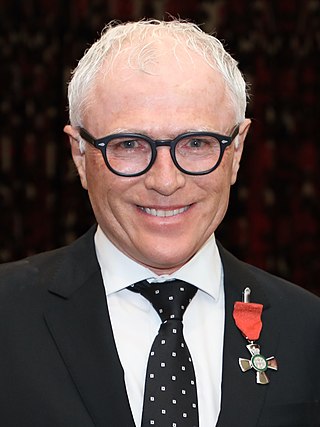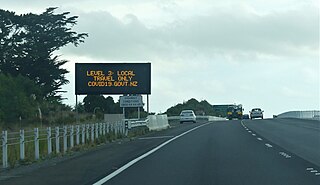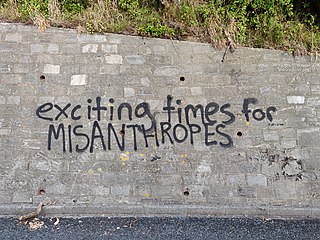Related Research Articles

Michael George Baker is a New Zeland epidemiologist. He is a professor of public health at the University of Otago. Baker has worked as an advisor and member of multiple organisations. Notably, Baker is a member of the New Zealand Food Safety Authority's Academy and of the New Zealand Ministry of Health's Pandemic Influenza Technical Advisory Group (PITAG).
The COVID-19 pandemic in New Zealand was part of the pandemic of coronavirus disease 2019 caused by severe acute respiratory syndrome coronavirus 2. The first case of the disease in New Zealand was reported on 28 February 2020. The country recorded over 2,274,370 cases. Over 3,000 people died as a result of the pandemic, with cases recorded in all twenty district health board (DHB) areas. The pandemic first peaked in early April 2020, with 89 new cases recorded per day and 929 active cases. Cases peaked again in October 2021 with 134 new cases reported on 22 October.

Managed isolation and quarantine (MIQ) was a quarantine system implemented by the New Zealand Government during the country's COVID-19 pandemic. Under the system, people entering New Zealand, COVID-19 positive cases and some of their close contacts were required to isolate at an MIQ facility for 14 days. Compulsory managed isolation and quarantine was announced by Prime Minister Jacinda Ardern at the 1pm press conference on 9 April 2020, with the system coming into effect for people boarding flights to New Zealand from midnight that day. The government contracted dozens of hotels in five cities that were exclusively used as managed isolation facilities. The task was organised by the Managed Isolation and Quarantine (MIQ) unit, part of the COVID-19 All-of-Government Response Group.
There were several COVID-19 protests in New Zealand held during the period of COVID-19 restrictions from 2020 to 2022, where people protested the government's response to the COVID-19 pandemic in New Zealand, in particular the lockdown measures in place in March–May 2020, August 2020, and August–November 2021 and the later vaccine mandates. The protests have been largely condemned by members of parliament, as well as local city and regional councils. Fears were also raised about the protests increasing the spread of the virus.
A four-tier alert level restrictions system was in place in during the COVID-19 pandemic in New Zealand between March 2020 and December 2021, with levels 3 and 4 being forms of lockdown. In level 1 there were no restrictions; in level 2 there were limits on gatherings; in level 3 only purposeful travel was allowed and there were strict limits on gatherings; and in level 4 only essential travel was allowed and gatherings were banned.

This article documents the chronology of the response to the COVID-19 pandemic in February 2021, which originated in Wuhan, China in December 2019. Some developments may become known or fully understood only in retrospect. Reporting on this pandemic began in December 2019.

The New Zealand Government responded to the COVID-19 pandemic in New Zealand in various ways. In early February 2020, the Government imposed travel restrictions on China in response to the global COVID-19 pandemic originating in Wuhan and also repatriated citizens and residents from Wuhan. Following the country's first case, which originated in Iran, the Government imposed travel restrictions on Iran.

The COVID-19 pandemic in New Zealand has had far-reaching consequences on the country that went beyond the spread of the disease itself and efforts to eliminate it, including education, faith communities, Māori, mass gatherings, sports, recreation, and travel. In addition, there were several recorded cases of lockdown violations, leaks, and misinformation about the COVID-19 virus and vaccines.

COVID-19 vaccination in New Zealand began on 20 February 2021, and will continue throughout the pandemic with the goal of vaccinating all willing New Zealanders aged 5 or older. Those aged 5 to 11 require a parent, caregiver or legal guardian accompany them to their appointment and provide consent for them to be vaccinated. As of 1 September, anyone in New Zealand, regardless of their immigration status, is eligible to be vaccinated.

This article documents the chronology of the response to the COVID-19 pandemic in August 2021, which originated in Wuhan, China in December 2019. Some developments may become known or fully understood only in retrospect. Reporting on this pandemic began in December 2019.

This article documents the chronology of the response to the COVID-19 pandemic in September 2021, which originated in Wuhan, China in December 2019. Some developments may become known or fully understood only in retrospect. Reporting on this pandemic began in December 2019.

This article documents the chronology of the response to the COVID-19 pandemic in October 2021, which originated in Wuhan, China in December 2019. Some developments may become known or fully understood only in retrospect. Reporting on this pandemic began in December 2019.

This article documents the chronology of the response to the COVID-19 pandemic in November 2021, which originated in Wuhan, China in December 2019. Some developments may become known or fully understood only in retrospect. Reporting on this pandemic began in December 2019.

This article documents the chronology of the response to the COVID-19 pandemic in December 2021, which originated in Wuhan, China in December 2019. Some developments may become known or fully understood only in retrospect. Reporting on this pandemic began in December 2019.
My Vaccine Pass was a vaccine certificate issued by the New Zealand Government that served as an official record of one's COVID-19 vaccination status during the COVID-19 pandemic. The vaccine pass was required to enter hospitality venues, community, sport and faith-based gatherings, as a result of the COVID-19 Protection Framework having come into effect on 3 December 2021. The passes expired on 1 June 2022.

This article documents the chronology of the response to the COVID-19 pandemic in January 2022, which originated in Wuhan, China in December 2019. Some developments may become known or fully understood only in retrospect. Reporting on this pandemic began in December 2019.

This article documents the chronology of the response to the COVID-19 pandemic in February 2022, which originated in Wuhan, China in December 2019. Some developments may become known or fully understood only in retrospect. Reporting on this pandemic began in December 2019.

This article documents the chronology of the response to the COVID-19 pandemic in March 2022, originating in Wuhan, China in December 2019. Some developments may become known or fully understood only in retrospect. Reporting on this pandemic began in December 2019.

The COVID-19 Response (Vaccinations) Legislation Act 2021 is an Act of Parliament to provide a legal framework for the New Zealand Government's COVID-19 Protection Framework and vaccination mandates. The bill was introduced under urgency and passed in law on 23 November 2021. While the bill was supported by the Labour Government and their Green coalition partners, it was opposed by the opposition National, ACT, and Māori parties, which criticised the rushed and divisive nature of the legislation and claimed that vulnerable communities would be adversely affected.

This article documents the chronology of the response to the COVID-19 pandemic in September 2022, which originated in Wuhan, China in December 2019. Some developments may become known or fully understood only in retrospect. Reporting on this pandemic began in December 2019.
References
- ↑ "COVID-19 Protection Framework (Traffic lights)". 15 August 2023.
- 1 2 3 4 5 "COVID-19 Protection Framework". Unite against COVID-19. New Zealand Government. Archived from the original on 29 November 2021. Retrieved 27 November 2021.
- 1 2 3 "Covid-19 traffic light system scrapped: All you need to know". The New Zealand Herald . 12 September 2022. Archived from the original on 11 December 2024. Retrieved 26 December 2024.
- 1 2 3 "COVID-19 (novel coronavirus)". Ministry of Health. 12 September 2022. Archived from the original on 12 September 2022. Retrieved 12 September 2022.
- ↑ "My Vaccine Pass". 8 December 2022.
- ↑ "PM announces Covid-19 vaccine certificate". Radio New Zealand . 5 October 2021.
- ↑ "Concerns lax hospitality venues not scanning vaccine passes". 23 December 2021.
- ↑ "Coronavirus: PM Jacinda Ardern outlines NZ's new alert system, over-70s should stay at home". The New Zealand Herald . 21 March 2020. Archived from the original on 27 November 2021. Retrieved 27 November 2021.
- ↑ "COVID-19: Elimination strategy for Aotearoa New Zealand". Ministry of Health. Archived from the original on 2 December 2021. Retrieved 27 November 2021.
- ↑ Hall, Kristin (15 October 2021). "Govt to ditch alert levels for new traffic light system". 1News . TVNZ. Archived from the original on 29 November 2021. Retrieved 27 November 2021.
- 1 2 "PM expects Auckland to move to traffic light system in three weeks". Radio New Zealand . 8 November 2021. Archived from the original on 27 November 2021. Retrieved 27 November 2021.
- ↑ Wiles, Siouxsie (22 September 2021). "Siouxsie Wiles: Why we need to stay the course on elimination". The Spinoff . Archived from the original on 14 October 2021. Retrieved 18 October 2021.
- ↑ "Covid-19 Delta outbreak: Government can't afford to rule out level 4 return – modeller Shaun Hendy". The New Zealand Herald . 18 October 2021. Archived from the original on 18 October 2021. Retrieved 18 October 2021.
- ↑ "Mandate legislation pushed through Parliament amid fierce opposition". Radio New Zealand . 24 November 2021. Archived from the original on 24 November 2021. Retrieved 24 November 2021.
- ↑ Manch, Thomas (23 November 2021). "Covid-19: Critics condemn urgent passing of 'traffic light' law without usual scrutiny". Stuff . Archived from the original on 2 December 2021. Retrieved 3 December 2021.
- ↑ Manch, Thomas (17 November 2021). "Covid-19: Government to open Auckland border on December 15, allowing travel for Christmas". Stuff . Archived from the original on 6 December 2021. Retrieved 8 December 2021.
- ↑ Cheng, Derek (8 December 2021). "Covid 19 Delta outbreak: Revealed - The public health advice to have Auckland unshackled by now and why Jacinda Ardern rejected it". The New Zealand Herald . Archived from the original on 7 December 2021. Retrieved 8 December 2021.
- ↑ Ensor, Jamie (8 December 2021). "Christopher Luxon calls for Auckland border to be lifted 'tonight' after previously unreleased public health advice emerges". Newshub . Archived from the original on 7 December 2021. Retrieved 8 December 2021.
- ↑ "Watch live: Prime Minister Jacinda Ardern announces any changes to traffic light system". Radio New Zealand . 13 December 2021. Archived from the original on 13 December 2021. Retrieved 13 December 2021.
- ↑ "Govt under fire for not dropping Auckland's Covid-19 Protection Framework settings sooner". Radio New Zealand . 13 December 2021. Archived from the original on 13 December 2021. Retrieved 13 December 2021.
- ↑ Quinn, Rowan (13 December 2021). "Too early for Auckland and other regions to move out of red - experts". Radio New Zealand . Archived from the original on 12 December 2021. Retrieved 13 December 2021.
- ↑ "Dunedin only southern council insisting on passports so far". Otago Daily Times . 2 December 2021. Archived from the original on 2 December 2021. Retrieved 2 December 2021.
- ↑ Savory, Logan (7 December 2021). "Invercargill councillors introduce vaccine mandate at some council facilities". Stuff . Archived from the original on 8 December 2021. Retrieved 17 December 2021.
- ↑ "Covid-19 Omicron: Chris Hipkins reveals decision on borders, boosters amid Omicron threat". The New Zealand Herald . 21 December 2021. Retrieved 21 December 2021.
- ↑ "COVID-29: Omicron outbreak would push New Zealand back to red traffic light setting, says Jacinda Ardern". Radio New Zealand . 17 January 2022. Archived from the original on 17 January 2022. Retrieved 18 January 2022.
- ↑ Piper, Denise (20 January 2022). "Covid-19: Northland to move to orange traffic light setting on Thursday night". Stuff . Archived from the original on 20 January 2022. Retrieved 23 January 2022.
- ↑ Ardern, Jacinda (20 January 2022). "Northland to move to Orange, NZ prepared for Omicron". Beehive.govt.nz. New Zealand Government. Archived from the original on 23 January 2022. Retrieved 23 January 2022.
- ↑ Ardern, Jacinda (23 January 2022). "New Zealand to move to Red from 11.59pm today". Beehive.govt.nz. New Zealand Government. Archived from the original on 23 January 2022. Retrieved 23 January 2022.
- ↑ "New Zealand adds new restrictions and Ardern delays her wedding as omicron spreads". National Public Radio . Associated Press. 23 January 2022. Archived from the original on 23 January 2022. Retrieved 23 January 2022.
- ↑ Neilson, Michael (23 March 2022). "Covid 19 Omicron rules changed: Outdoor gathering limits scrapped; vaccine passes and some mandates end April 4 - Jacinda Ardern". The New Zealand Herald . Archived from the original on 23 March 2022. Retrieved 23 March 2022.
- 1 2 3 Whyte, Anna (23 March 2022). "PM reveals changes to mandates, vaccines passes and restrictions". 1News . Archived from the original on 14 December 2024. Retrieved 26 December 2024.
- ↑ "Vaccine passes, QR codes no longer a requirement - Ardern". 1News . TVNZ. 23 March 2022. Archived from the original on 25 March 2022. Retrieved 5 April 2022.
- 1 2 "Covid-19 Omicron outbreak: Orange for Easter! NZ to move to new traffic light setting from midnight; 9495 new community cases". New Zealand Herald . 13 April 2022. Archived from the original on 13 April 2022. Retrieved 13 April 2022.
- ↑ "Covid-19: All of NZ to move to orange setting from 11.59pm tonight". Radio New Zealand . 13 April 2022. Archived from the original on 13 April 2022. Retrieved 13 April 2022.
- ↑ Hudson, Daisy (3 September 2022). "'Critical oversight' in mask consultation". Otago Daily Times . Allied Press. Archived from the original on 5 September 2022. Retrieved 13 September 2022.
- ↑ Venuto, Damien (8 September 2022). "The Front Page: Michael Baker on what should follow the Covid-19 traffic light framework". The New Zealand Herald . Archived from the original on 8 September 2022. Retrieved 9 September 2022.
- ↑ Trevett, Claire; Pearse, Adam (8 September 2022). "Covid 19: Gone by Wednesday? Government set to decide on scrapping traffic light system, other orders". The New Zealand Herald . Archived from the original on 8 September 2022. Retrieved 9 September 2022.
- ↑ "Air NZ drop mask requirement following government's decision". 1News . TVNZ. 12 September 2022. Archived from the original on 12 September 2022. Retrieved 13 September 2022.
- ↑ Houlahan, Mike (13 September 2022). "Back to normal life as Covid restrictions end". Otago Daily Times . Allied Press. Archived from the original on 13 September 2022. Retrieved 13 September 2022.
- ↑ Wiles, Siouxsie (12 September 2022). "Ditching Covid restrictions now could be a big and expensive mistake". The Spinoff . Archived from the original on 12 September 2022. Retrieved 13 September 2022.
- ↑ Ardern, Jacinda (29 November 2021). "Traffic light levels announced". Beehive.govt.nz. New Zealand Government. Archived from the original on 2 December 2021. Retrieved 7 December 2021.
- ↑ "Traffic light setting changes for some North Island regions from tonight". Radio New Zealand . 30 December 2021. Archived from the original on 3 January 2022. Retrieved 4 January 2022.
- ↑ Ardern, Jacinda (20 January 2022). "Northland to move to Orange, NZ prepared for Omicron". Beehive.govt.nz. New Zealand Government. Archived from the original on 23 January 2022. Retrieved 23 January 2022.
- ↑ Cooke, Henry (23 January 2022). "Covid-19 NZ: New Zealand to move to red at 11.59pm tonight after mystery Omicron cases". Stuff . Archived from the original on 23 January 2022. Retrieved 23 January 2022.